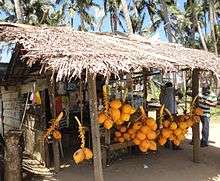King coconut


King coconut (Cocos nucifera) is a variety of coconut, native to Sri Lanka[1] where it is known as Thembili (Sinhala: තැඹිලි). Sweeter than regular coconuts, there are several sub varieties of the king coconut-the most common being the "red dwarf" (kaha thambili, commonly referred to as gon thambili). The other variety is "ran thambili",[2] a smaller variety containing about forty nuts in a bunch. The king coconut tree is shorter than coconut trees, and are found commonly growing wild in many areas of the country.[3]
King coconut water has been used in Ayurveda. One of the most common uses is a mixture of Aralu powder (Myrobalans) added to the water of one king coconut.[4]
This Aralu brew according to Sri Lankan ayurvedic practitioners (also known as veda mahattayas) has the necessary properties to "expel heat from the body" therefore resulting in a feeling of freshness.
Sri Lanka now exports packaged king coconut water.
There are many cultivated coconut varieties found in Sri Lanka. Most of them are underway through national coconut research institute. According to a research carried away, they identified these varieties during a recent coconut germplasm exploration mission in the Southern Province of Sri Lanka.
Coconut in Sri Lanka is currently classified into 15 different coconut forms grouped under three varieties, namely 'Typica', 'Nana' and 'Aurantiaca'. The visual morphological features of several new coconut morphotypes were characterized with the objective of including them in the taxonomic classification of coconut in Sri Lanka.[5]It is also found in some parts of Kerala, here it is known as (Chomana Thenga) or red coconut.
Varieties and forms of coconut found in Sri Lanka
| Common name | Variety/form | Features |
|---|---|---|
| Sri Lanka Tall | (Typical/Typica) | Tall stature, allogamous, heterogeneous, flowers in 6–7 years, medium-sized nuts, 20–25 nuts per bunch, 60–80 nuts per palm per year. |
| Gon Thembili | (Typica/Gon thembili) | Similar to Sri Lanka Tall. Ivory-coloured nuts, petioles, and inflorescences. |
| Nawasi | (Typica/Nawasi) | Similar to Sri Lanka Tall. Soft mesocarp edible in the immature nut. Yields soft fibre when mature. |
| Pora pol | (Typica/Pora pol) | Similar to Sri Lanka Tall. Remarkably thick-shelled nuts. |
| Ran Thembili | (Typica/Ran thembili) | Similar to Sri Lanka Tall. Pink-coloured mesocarp in immature fruit and a pink whorl under the perianth. Large nuts. |
| Kamandala | (Typica/Kamandala) | Similar to Sri Lanka Tall. Large-sized nuts (largest among local forms), and few nuts per bunch (2–5 nuts per bunch). |
| Bodiri | (Typica/Bodiri) | Similar to Sri Lanka Tall. Small-sized nuts, and large number per bunch (30–100 nuts per bunch). Seasonal nut production. |
| Dikiri | (Typica/Dikiri) | Similar to Sri Lanka Tall. Some nuts contain a jelly-like endosperm. |
| King Coconut | (Aurantiaca/King coconut) | Intermediate stature, autogamous, homogeneous, fruits in 6–7 years, seasonal flower production, medium-sized nuts with orange epicarp, and sweet nut water; 25–50 nuts per bunch. |
| Nawasi Thembili | (Aurantiaca/Nawasi thembili) | Similar to King Coconut. Soft and edible mesocarp like Nawasi. |
| Rathran Thembili | (Aurantiaca/Rathran thembili) | Similar to King Coconut. Pink-coloured mesocarp, and a pink whorl under the perianth. |
| Green Dwarf | (Nana/Green dwarf or Pumila) | Dwarf stature, autogamous, homogeneous, fruits in 3–4 years, small-sized nuts with green epicarp. Low copra content, 80–150 nuts per palm per year. |
| Yellow Dwarf | (Nana/Yellow dwarf or Eburnea) | Similar to Green dwarf. Nuts with yellow epicarp. |
| Red Dwarf | (Nana/Red dwarf or Regia) | Similar to Green dwarf. Nuts with red epicarp. |
| Brown Dwarf | (Nana/Brown dwarf or Braune) | Similar to Green dwarf. Nuts with a brown epicarp. |
See also
References
- ↑ "WHAT IS KING COCONUT?".
- ↑ "Thambili - Punchi Lindey Vathura Rasai". Archived from the original on 2016-03-03.
- ↑ "Coconut varieties". florida gardener. Retrieved 19 May 2016.
- ↑ "King Coconut" (PDF).
- ↑ Ekanayake, G.K. , Perera, S. A. C. N. , Dassanayake, P. N. , Everard, J. M. D. T. (2010). "Varietal Classification of New Coconut (Cocos nucifera L.) Forms Identified" (PDF). Coconut Research Institute of Sri Lanka. p. 10. Retrieved 19 May 2016.